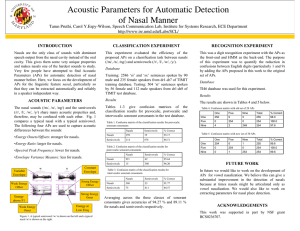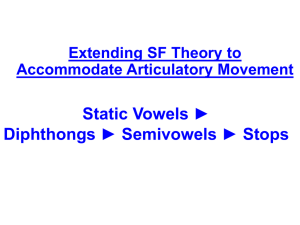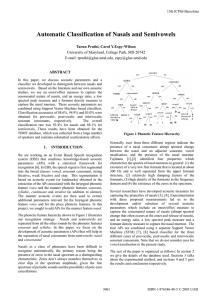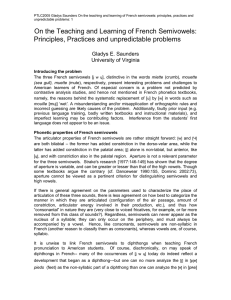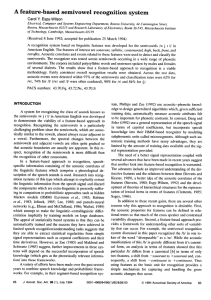A PHONETICALLY BASED SEMIVOWEL RECQGNITION SYSTEM Y. Carol
advertisement
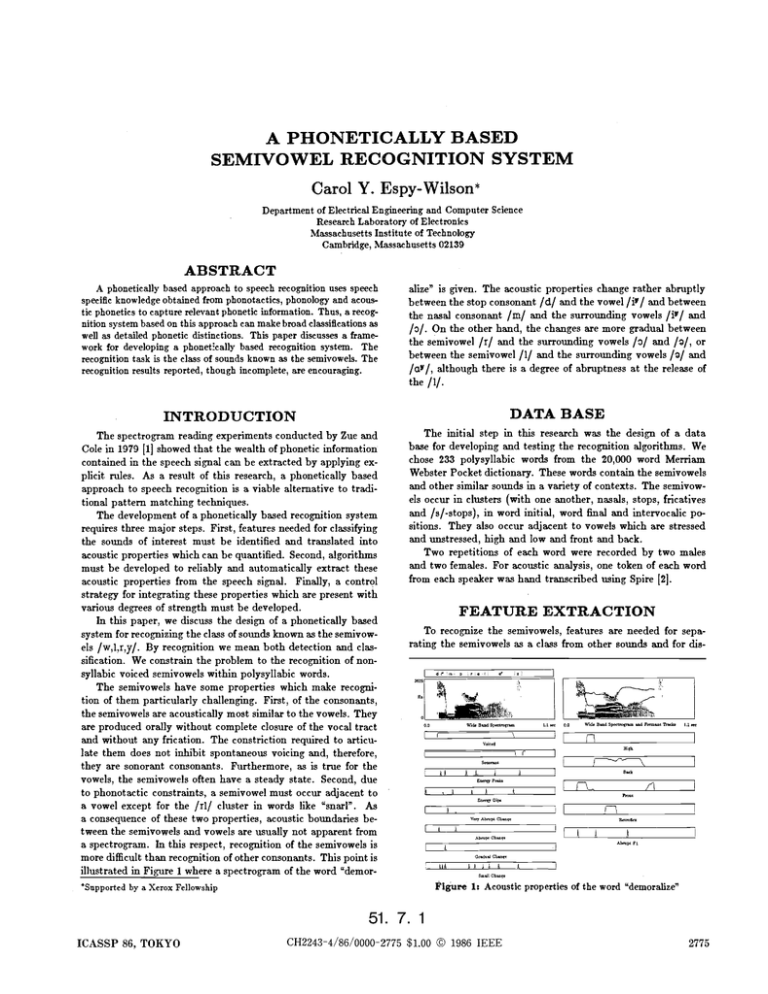
A PHONETICALLY BASED
SEMIVOWEL RECQGNITION SYSTEM
Carol Y. Espy-Wilson*
Department of Electrical Engineering and Computer Science
Research Laboratory of Electronics
MassachusettsInstitute of Technology
Cambridge, Massachusetts02139
ABSTRACT
A phonetically based approach to speech recognition uses speech
specific knowledge obtained from phonotactics, phonology and acous-
alize” is given. The acoustic properties change rather abruptly
between the stopconsonant /d/ and thevowel /P/ and between
the nasal consonant /m/ and the surrounding vowels /P/ and
/3/. On the other hand, the changes are more gradual between
the semivowel /r/ and the surrounding vowels /3/ and /a/, or
between the semivowel /1/ and the surrounding vowels /a/ and
/av/, although there is a degree of abruptness at the release of
the /I/.
tic phonetics to capture relevant phonetic information. Thus, a recogas
nition system basedon this approach can make broad classiflcations
wellas detailed phonetic distinctions. This paper discusses a frameworkfordeveloping a phonettcallybasedrecognitionsystem.The
recognition task is the class of sounds known as the semivowels. The
recognition results reported, though incomplete, are encouraging.
INTRODUCTION
DATA BASE
The spectrogram reading experiments conducted by Zue and
Cole in 1979 [I] showed that the wealth of phonetic information
contained in the speech signal can be extracted by applying explicit rules. As a result of this research, a phonetically based
approach to speech recognition is a viable alternative to traditional pattern matching techniques.
The development of a phonetically based recognition system
requires three major steps. First, features needed for classifying
the sounds of interest must be identified and translated into
acoustic properties which can be quantified. Second, algorithms
must be developed to reliably and automatically extract these
acoustic properties from the speech signal. Finally, acontrol
strategy for integrating these properties which are present with
various degrees of strength must be developed.
In this paper, we discuss the design of a phonetically based
system for recognizing the class of sounds known as the semivowels /w,l,r,y/. By recognition we mean both detection and classification. We constrain the problem to the recognition of nonsyllabic voiced semivowels within polysyllabic words.
The semivowels have some properties which make recognition of them particularly challenging. First, of the consonants,
the semivowels are acoustically most similar to the vowels. They
are produced orally without complete closure of the vocal tract
and without any frication. The constriction required to articulate them does not inhibit spontaneous voicing and, therefore,
they are sonorant consonants. Furthermore,
as is true for the
vowels, the semivowels often have a steady state. Second, due
to phonotactic constraints, a semivowel must occur adjacent to
a vowel except for the /rl/ clusterin words like “snarl”. As
a consequence of these two properties, acoustic boundaries between the semivowels and vowels are usually not apparent from
a spectrogram. In this respect, recognition of the semivowels is
more difficult than recognition of other consonants. This point is
illustrated in Figure 1 where a spectrogram of the word “demor-
The initial step in this research was the design of a data
base for developing and testing the recognition algorithms. We
chose 233 polysyllabic words from the 20,000 word Merriam
Webster Pocket dictionary. These words contain the semivowels
and other similar sounds in a variety of contexts. The semivowels occur in clusters (with one another, nasals, stops, fricatives
and /s/-stops), in word initial, word final and intervocalic positions. They also occur adjacent to vowels which are stressed
and unstressed, high and low and front and back.
Two repetitions of each word were recorded by two males
and two females. For acoustic analysis, one token of each word
from each speaker was hand transcribed using Spire [2].
FEATURE EXTRACTION
To recognize the semivowels, features are needed for separating the semivowels as a class from other sounds and for dis-
Figure 1: Acoustic properties of the word “demoralize”
*Supported by a Xerox Fellowship
51.
ICASSP 86, TOKYO
7
‘I.
1
I
CH2243-4/86/0000-2775 $1.00 0 1986 IEEE
2775
t
Table I: Features which characterize various classesof consonants
stop nasal high back front retroflex
nasals
/w/
/Y/
1.1
+ + +
+ + - - + - +
+ - - + -
2.0
1.0
kHz
FZ.F1
-
Figure 2: DifTerencein Formant Frequency Values for Intervocdic
Semivowels
+
light /l/
dark /1/
Table 2: Features for separating semivowelsfrom nasals and for discriminating between the semivowels
tinguishing between the semivowels. Shown in Tables 1 and 2
are the features needed to make these classifications. A "+"
means that the speech sound(s) indicated has the designated
feature and a y-" means the speech sound(s) does not have the
designated feature. If there is no entry, then the feature is not
specified or is not relevant.
Based on the features in Table 1, we note that the class
of segments of interest in this study is identified by a "+' for
each of the three features. Furthermore, the nasals, which are
also sonorant consonants, are the only other sounds so defined.
Thus,based on these features, the voiced sonorant consonants
should be discriminated from other speech sounds. The features in Table 2 are needed to separate the semivowels from the
nasals and to identify the individual semivowels. The feature
high is defined slightly differently from the conventional way,
but its acoustic correlate is a low first formant frequency. Two
allophones of /1/ are specified, light /1/ and dark 111. Dark /1/
occurs in syllable hal position whereas a light /1/ occurs in
other syllable positions.
Considerable research (e.g. [3]) has been done studying the
perceptual and acoustic properties of the semivowels. This research has indicated the patternof formant frequencies that distinguish between the semivowels. This can be seen in Figure 2
where the frequency difference between F2 and F1 andbetween
F3 and F1 are shown for the intervocalic semivowels spoken by
one of the female talkers. The formant tracks were automatically extracted and the formant frequencies were measured in
the middle of the transcribed semivowels. The frequency difference between F3 and F1, which is one of the acoustic properties used to detect retroflexion, separates /r/ from the other
semivowels. In addition, the frequency difference between F2
and F1, which is used to extract the features front and back,
clearly separates /y/ from the other semivowels and partially
separates /w/from 111.
Table 3 contains the present mapping of the features listed
in Tables 1 and 2 into measurable acoustic properties. Based
on our present knowledge of acoustic phonetics, some features
can be extracted more reliably than others. For example, the
feature sonorant can be reliably extracted using energy based
parameters while the feature high is not as easy to extract since
reliable computation of formant tracks can be difficult.
As indicated in Table 3, no absolute thresholds are used to
quantify the acoustic properties. Instead, we used relative measures which tend to make the properties independent of speaker,
recording level, and recording environment. These measures are
based on anchor points within the specific utterance being analyzed. Each measure examines an attribute in one speech frame
in relation to another frame, or, within a given frame, examines
one part of the spectrum in relation to another. Thus, for example, in the extraction of the feature voiced, which is based
on the bandlimited energy 200 Hz to 700 Hz, the classification
of each speech frame within the utterance was based on the
energy in that frame with respect to the maximum energy measured within the entire utterance. On the other hand, in the
extraction of the feature sonorant, the energies in the frequency
bands 0 Hz to 300 Hz and 3700 Hz to 7000 Hz were compared
on a frame by frame basis.
The framework provided by fuzzy set theory [6]is used to
quantify each property into the range [0,1]. A value of 1 means
we are confident thattheproperty is present. Conversely, a
value of 0 means we are confident that the acoustic property is
absent. Values in between these two extremes represent a fuzzy
area with the value indicating our level of certainty that the
property is presentlabsent.
As an example of how this framework is applied, consider
the quantification of the acoustic property used to extract the
feature nonsyllabic. The acoustic correlate of this feature is significantly less energy in the consonant regions than in the vowel
Feature
/Parameter
j Property
Voiced
IEnergy
200-700 Hz
/High (Relative)
Sonorant
Energy Ratio (0-300)/(3700-7000)
Nonsyllabic Energy 640-2800Low
Hz
(Relative)
Energy 2000-3000 Hz
Low (Relative)
High
1st Difference of Total Energy
stop
High
1st Difference of F1
Present
Nasal Formant
Nasal
Low
F 1 - FO
High
Low
F2 - F1
Back
High
Front
F2 - F1
Low
Retroflex F3 - FB
I
'1
'
Table 3: Parameters and Properties for Feature Extraction
51. 7. 2
2776
ICASSP 86, TOKYO
dB
so.9
. ) I
ified by the voiced property.
CONTROL STRATEGY
(
I
,
1, , , , / ,
/
a
10.0
20.0
I””””’
30.0
dB
40.0
2 w O Hz. 3000 Hz
Figure 3: Energy Dip in Intervocalic Semivowels
regions. In an attempt to define this property of “less energy”
more precisely, we selected the bandlimited energies 640 Hz to
2800 Hz and 2000 Hz to 3000 Hz and examined their effectiveness in identifying the presence of intervocalic semivowels. For
each of these parameters, the differences between the minimum
energy within the semivowels and the maximum energy within
the adjacent vowels was measured. The smaller of these two differences indicates the significance of the energy dip. A scatter
plot of the range of values of this energy dip for the two bandlimited energies is shown in Figure 3. We also looked at the
range of values of energy dips within the vowel regions. Less
than 1% of the vowels contained an energy dip. Furthermore,
these energy dips tended to be less than 2 dB.
Based on these data, this property was quantified into the
regions shown in Figure 4. An energy dip of 2 dB or more definitely indicates a nonsyllabic segment. If an energy dip between
1 dB and 2 dB is measured, we are uncertain as to whether a
nonsyllabic segment is present or not. Finally, energy dips of
less than 1 dB are not indicative of a nonsyllabic segment.
Examples of the quantified properties for the word “demoralize’ are shown in Figure 1. The energy based properties are
shown on the left and theformant based propertiesare shown on
the right. The automatically extracted formant tracks are overlaid on the second spectrogram. Note that the feature stop was
quantified intothe properties “very abrupt change”, “abrupt
change” “gradual change” and “small change”.
Some properties, such as the voiced property, define a region(s) within the speech signal whereas others,such as the
energy dip property, mark instants of time. The amplitude of
each property indicates our level of certainty that the property
is present. Some of the properties are extracted independently
of one another. However, the knowledge gained from some of
the properties is used in the extraction of other properties. For
example, the formants are only tracked within the region spec-
syllabic
maybe nonsyllabic
1.0
”
nonsyllabic
2.0
Breakpoints
Figure 4: Quantifleation of Energy Dip Property
dB
To classify the semivowels, rules were written integrating the
extracted acoustic properties. At the writing of this paper, the
formant tracker developed for this recognition system was being refined. Therefore, some of the more detailed phonetic distinctions could not be made. However, using the energy based
properties, a rule was written for the detection of sonorant consonants. Having detected these segments, another rule, which
is also incomplete without formant information, was written to
separate the semivowels from other sonorant consonants or imposters. In general, the imposters include the nasals only, dthough other voiced consonants are sometimes sonorant when
in intervocalic position. To compensate somewhat for missing
formant information, the properties‘murmur”,“maybe
murmur” and ‘no murmur” were used to help separate nasals from
semivowels. These properties were based on the ratio of the
bandlimited energy 0 Hz to 400 Hz to the bandlimited energy
400 Hz to 1000 Hz.
The rules written to recognize the semivowels are:
SONORANT CONSONANT = (NONSYLLABIC)(VOICED)
(SONORANT)
SEMIVOWEL = (SONORANT CONSONANT)
{[(NO MURMUR) + (MAYBE MURMUR)]
(NOT STOP LIKE) +
(NO MURMUR)(STOP LIKE)}
IMPOSTERS = (SONORANT CONSONANT)
{(MURMUR)
(VERY STOP LIKE)
(MAYBE MURMUR)(STOP LIKE))
+
+
where ”very stop like”, “stop l i e ” and “not stop like” are also
rules which arebased on the spectral change properties displayed in Figure 1.
From the sonorant consonant rule, the energy dips detected
must occur withina voiced and sonorant region. Having detected such an energy dip, the spectral change properties are
extracted from the region surrounding the energy dip. In the
case of intervocalic semivowels, this region is defined by the energy peaks that are adjacent to the energy dip. These energy
peaks are required to be in a voiced and sonorant region as well.
That is, they should occur within the adjacent vowels. For prevocalic and postvocalic semivowels, this region is defined by the
adjacent energy peak and the beginning or end of the voiced
sonorant region, respectively.
In the recognition rules, the addition or “+” operation of
properties is analogous to a logical “or”. The result of this operation is the maximum value of the properties being operated
on. Themultiplication of properties is analogous to a logical
“and”. The result of thisoperation is the minimum value of
the properties being operated on. Thus, since the value of each
property must be in the range [0,1], the scores obtained by a p
plying these rules must also be in the range [0,1].
Note that a rule was also written to classify imposters. This
rule and the semivowel rule are applied to each detected sonorant consonant. Thus, animposter which classifies as asemivowel
will hopefully classify as an imposter with a higher score. To
51. 7.3
ICASSP 86. TOKYO
2777
!
semivowels nasals other imposters
445
84
a7
total
detected
411
83
60
Table 4: The number of possible intervocalic sonorant consonants
containing an energy dip.
1 :; :t 1
classification I
identification
/semivowels imposters
semivowel
imposter
not class.
Table 5: Classillcation of Intervocalic Segments
classify as a semivowel or an imposter, the scores obtained from
these rules must be greater than 0.5.
This section contains preliminary results for the detection
and classification of intervocalic sonorant consonants. The convex hull algorithm developed by Mermelstein(41 was used to
detect these intervocalic energy dips within the energy bands
mentioned in Table 3.
DQteCtiOlnQfb t C T V O e l a k ~ ~ T l .COTl.SOnESls$
Q ~ ~ t
To qualify as occurring within an intervocalic sonorant consonant, the detected energy dip must be surrounded by energy
peaks which also occur in voiced and sonorant regions. As mentioned earlier, such energy peaks should occur within the adjacent vowels. Table 4 summarizes the results obtained with this
strategy. The row labeled “total” is the number of such intervocalic consonants tramscribed in the data base. As mentioned
earlier, the other imposters includes other voiced consonants
which are sometimes sonorant when in intervocalic position. In
this study, we defined the “other imposters” to be /h/, If/, /u/
and /a/ when, according to the transcription of the words in
the data base, they occurred in intervocalic position.
tion before a vowel. With formant information, particularly the
frequency of FB,we expect to do considerably better. Shown
in Figwe 5 is a multi-histogram of the frequency of FB of the
intervocalic semivowels and nasals. As was true in Figure 2,
these data were automatically extracted from the words spoken by one of the female talkers. There is little overlap in the
distribution of the F1 frequency sdues of the nasals and the
distribution of the PB frequency values of the /l/’s.
Of the imposters classified as semivowels, 53% were nasals.
All the nasals and other imposters were classified as nonsyllabic. That is, an energy dip was always contained within their
transcribed region. The 17 undetectedimposters, unlike the
semivowels and nasals, were also classified as either unvoiced,
nonsonorant orboth. One misclassification of the nasal /m/
(in the word “demoralize”) occurred because it was preceded
by a short /?/ (15 msec) such that the preceding energy peak
occurred at the release of the /d/ burst, an unvoiced region.
Of the 34 undetected semivowels, 94% were not classified as
nonsyllabic. That is, these semivowels were not found through
energy dip detection. Of those not classified as nonsyllabic, 91%
occurred after a stressed vowel and before an unstressed vowel,
such as the /r/ in “chlorination”.The remaining semivowels
not found through energy dip detection occurred before and
after unstressed vowels, such as the /I/ in “musculature”. Thus,
these semivowels do not have the nonsyllabic property. In the
6nal design of the recognition system, redundancy will be built
in such that other features, such 89 retroflex, can be used to
identify semivowels independently of the nonsyllabic property.
In addition to the consonants listed in Table 4, a few other
voiced consonants which are sometimes sonorant when in intervocalic position and a fewvowels also contained energy dips.
However, we will not discuss these segments here.
The energy change between these nasals and *adjacent voweis was too gradual for the nasals to be considered stop-lie.
Furthermore, the murmur property did
not distinguish these
nasals even though many of them can bedistinguished from the
semivowels on the basis of the frequency of FB.
Bn this paper, we develop a framework for a phonetically
based approach to speaker independent speech recognition. First,
we identify features for classifyiig the speech sounds of interest. Second, we develop algorithms to automaticallyextract
the acoustic correlates of these features. Finally, the extracted
propertiesareintegrated
in a set of recognition rules. Given
that all of the necessary acoustic properties are not used, the
recognition results obtained ~ p encouraging.
e
Classification of htelwoealic 8 e
Zue,V.W. and Cole, B.A., “Experimentson Spectrogram Beadkg”, PGASSP, pp. 116-819, April 1979.
Cyphers, D. s., “Spire: A Speech Researcb Tool”, S. M. Thesis,
T,1985.
Lehiste, I., ‘Acoustic Characteristics of Selected English Consonants,” Report No. 9, Univ. of Mch., Comm. Sciences Lab.,
Table 5 summarizes the results obtained by applying the classification rules t o the detected intervocalic segments. Given that
no formant information was used, the results are encouraging.
Only 7% of the semivowels were classified as imposters. Of these
semivowels, 54% were/l/’s which are often stop-like due to the
release of the tongue from the roof of the mouthin their produc-
Memebtein, P., ’Automatic Segmentation of Speech into Syllabic Units,” J. Acowt. Soc.Am, vol. 58, pp. 880-883,1975.
F a t , Gunnar, Acoustic Theorg of Speech P r o d u c t i o ~The Hague:
Mouton L Co., 1960.
DeMori, Renato, Computer Models of Speech Waing 1pgpzzg AG
gopithma New York and London: Plenum Press, 8983.
51.
2778
8962.
a.
4
